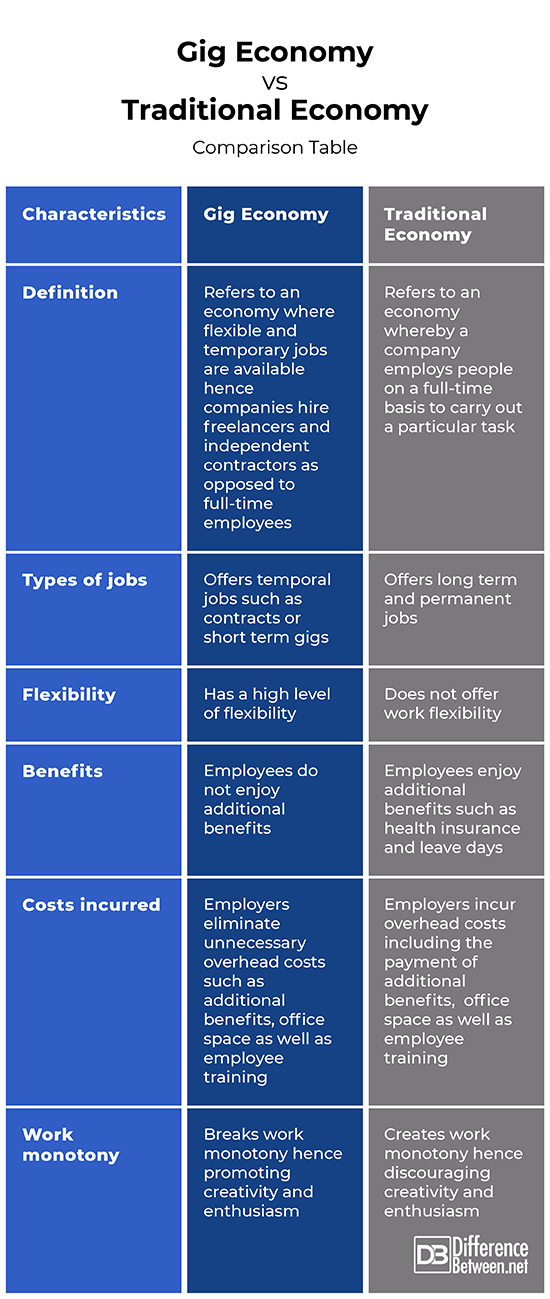Difference Between Gig Economy and Traditional Economy
As the number of new professions arises, working cultures, as well as environments, are constantly changing. While it was the norm for people to have one job at a time, various factors such as the rise in companies providing on-demand services such as Uber, a slowdown in traditional employment as well as the need for flexibility have created a work culture, commonly referred to as the gig economy. While these two economies are common in the modern world, they differ in various ways.

What is Gig Economy?
This is an economy where flexible and temporary jobs are available; hence companies hire freelancers and independent contractors instead of full-time employees. This economy works by bridging the gap between an employer, a task and a freelancer. Usually, payments are agreed upon by the two parties depending on the amount of work, the duration taken to complete the tasks as well as any other resources that may be used in the contract period. While this arrangement is especially favorable to most people due to the flexibility, the need for a constant pay may limit this. Recent research shows an increase in gig workers in developed as well as developing countries.
The advantages of a gig economy include;
- Employers can cut costs through the elimination of unnecessary overhead costs such as benefits, office space as well as training
- Employees enjoy a high level of flexibility
- Employees can work independently
- It breaks work monotony hence promotes creativity and enthusiasm
- Its time saving to companies in terms of the recruitment process
Despite the advantages, a gig economy has disadvantages including:
- While it is possible to earn a modest pay with the gig economy, most freelancers barely make enough to keep them going
- With the lack of provision of benefits, gig employees miss out on essential benefits such as health as well as insurance benefits
- The need to be consistently in the lookout for other gigs may put too much pressure on freelancers causing too much stress
Examples of companies that have adopted the gig economy include Uber, Fiverr, Instacart, Airbnb, and Hermes.

What is Traditional Economy?
This is an economy whereby a company employs people on a full-time basis to carry out a particular task. The working hours are agreed upon by the employer and the employees, with most ranging between seven and eight hours. This earns an employee a stable pay not to mention additional benefits such as health insurance and off days.
Advantages of the traditional economy include;
- Employees get a stable pay for the services provided to the company
- Employees get additional benefits such as health insurance and leave days
- Workers can focus on a chosen career path
However, the disadvantages include:
- It does not offer flexibility to the employees
- Companies incur overhead costs including the payment of benefits office space as well as training
- It creates work monotony as workers handle the same tasks every day
Similarities between Gig Economy and Traditional Economy
- In both, compensation for work carried out is provided
Differences between Gig Economy and Traditional Economy
Definition
The gig economy refers to an economy where flexible and temporary jobs are available hence companies hire freelancers and independent contractors instead of full-time employees. On the other hand, traditional economy refers to an economy whereby a company employs people on a full-time basis to carry out a particular task.
Types of jobs
While a gig economy offers temporal jobs such as contracts or short term gigs, a traditional economy offers long term and permanent jobs.
Flexibility
The gig economy offers a high level of flexibility. On the other hand, a traditional economy does not offer work flexibility.
Benefits
While employees under a gig economy do not enjoy additional benefits, employees under a traditional economy enjoy additional benefits such as health insurance and leave days.
Costs incurred
A gig economy enables employers to eliminate unnecessary overhead costs such as benefits, office space as well as training. On the other hand, employers under a traditional economy incur overhead costs including the payment of benefits office space as well as training.
Work monotony
While a gig economy breaks work monotony hence promoting creativity and enthusiasm, a traditional economy creates work monotony hence discouraging creativity and enthusiasm.
Gig Economy vs. Traditional Economy: Comparison Table

Summary of Gig Economy vs. Traditional Economy
The gig economy refers to an economy where flexible and temporary jobs are available hence companies hire freelancers and independent contractors instead of full-time employees. Employers hence eliminate unnecessary overhead costs such as additional benefits, office space as well as employee training. Although employees do not enjoy additional benefits, they enjoy a high level of flexibility.
On the other hand, traditional economy refers to an economy whereby a company employs people on a full-time basis to carry out a particular task. Although the jobs are not flexible, employees enjoy additional benefits such as health insurance and leave days not to mention the stable pay. Employers, however, incur overhead costs including the payment of additional benefits, office space as well as employee training.
- Difference Between Profit Center and Investment Center - July 2, 2022
- Difference Between Anti-Trust and Anti-Competition - June 6, 2022
- Difference Between Stocktaking and Stock Control - June 6, 2022
Search DifferenceBetween.net :
Leave a Response
References :
[0]Image credit: https://live.staticflickr.com/5161/5215872805_93f7491071_b.jpg
[1]Image credit: https://live.staticflickr.com/4698/38779290340_1ebc002b54_b.jpg
[2]World Development Report 2019: The Changing Nature of Work. World Bank. World Bank Publications, 2018. https://books.google.co.ke/books?id=Z7p1DwAAQBAJ&printsec=frontcover&dq=Difference+between+Gig+economy+and+Traditional+Economy&hl=en&sa=X&ved=0ahUKEwiVsJCH47jnAhWQXsAKHZx8B_o4ChDoAQhyMAk#v=onepage&q=Difference%20between%20Gig%20economy%20and%20Traditional%20Economy&f=false
[3]Ron McGowan. How to Find WORK in the Gig Economy: A Roadmap for Graduates and Precarious Workers. Page Publishing Inc, 2019. https://books.google.co.ke/books?id=ZxqMDwAAQBAJ&pg=PT27&dq=Difference+between+Gig+economy+and+Traditional+Economy&hl=en&sa=X&ved=0ahUKEwiDh9764rjnAhUVM8AKHa-sASIQ6AEIRzAE#v=onepage&q=Difference%20between%20Gig%20economy%20and%20Traditional%20Economy&f=false
[4]Jeremias Prassl. Humans as a Service: The Promise and Perils of Work in the Gig Economy. Oxford University Press, 2018. https://books.google.co.ke/books?id=prNSDwAAQBAJ&printsec=frontcover&dq=Difference+between+Gig+economy+and+Traditional+Economy&hl=en&sa=X&ved=0ahUKEwiDh9764rjnAhUVM8AKHa-sASIQ6AEILzAB#v=onepage&q=Difference%20between%20Gig%20economy%20and%20Traditional%20Economy&f=false
